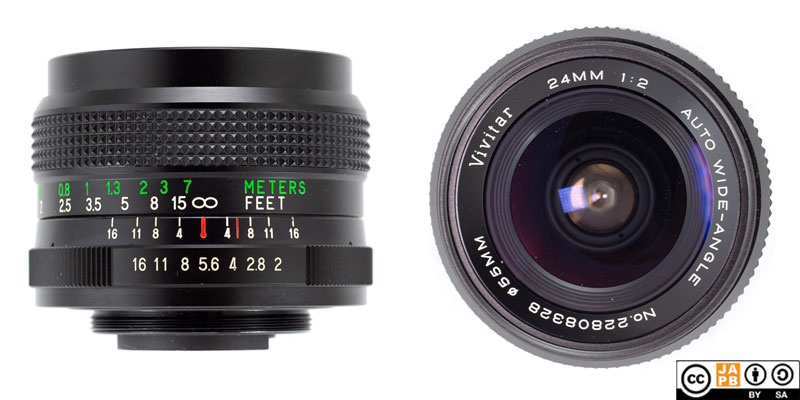Pekka Buttler, 03/2024

Specifications
The table below summarizes the lens’ key specifications (measurements based on pictured, last version of the lens):
| Brand: | Vivitar | Lens name | 24MM 1:2 auto wide-angle |
| Focal length(s)1 | 24 mm | Angle-of-view2 | 84° |
| Maximum Aperture | f/2 | In Production | 1978– |
| Lens mount (this lens) | M42 | Other lens mounts | multiple3 |
| Length4 | 46,5 mm | Diameter5 | 64,2 mm |
| Filter ring diameter | 55 mm | Weight | 244 grams |
| Lens element count | 8 | Lens group count | 8 |
| Aperture blades (S/R/C)6 | 6 S | Focus throw | 180 ° |
| Minimum focusing distance | 30 cms | Maximum magnification | 1:8,6 |
| Has manual aperture ring | YES | Has Manual focus ring | YES |
| Aperture mechanism type | Automatic | Aperture click stops 7 | 2•2.8•4•5.6•8•11-16 |
Further notes:
• Throughout the years, Vivitar sold two different lenses with the mainline specifications of a 24 mm focal length and an f/2 maximum aperture. This lens was designed and manufactured by Kino Precision (also known as Kiron) and carries the ’22’ serial number prefix. Also Komine (serial number prefix ’28’) manufactured a 24 mm f/2 lens for Vivitar and that is also often offered under the ‘Vivitar RL edition’ marque.
• The Kiron 24 mm f/2 MC lens is fundamentally the same lens as this lens, albeit in a cosmetically somewhat different package.
Versions and variations
Besides having a distant cousin in the Kiron 24 mm f/2, this Vivitar 24 mm f/2 was manufactured for a broad range of lens mounts, which in itself leads to some variation (with the difference in flange focal differences ranging from 40,5 mm to 46,5 mm). Hence the length of the Vivitar 24 mm f/2 will vary significantly based on which lens mount it has.
Interestingly, Kino precision seems to have taken the approach to use the added length of some lenses (due to FFD-variation) to enable a broader focusing ring. This can clearly be seen in that while the focus ring pattern (rubber, diamonds) is uniform, some lenses offer a ribber grip that is five rows of diamonds wide (such as the pictured M42 lens) while some lenses offered up to 8 rows of diamonds (specifically, the Konica AR version).
Similarly, some lenses will be all-black (such as the pictured lens, in M42 mount), some lenses will have a narrow silver band at the mount-end and some will have a broader silver ring .
However, there is nothing to indicate that any of these cosmetic variations would correspond to any changes in the optical recipe used in the different lenses.
History of Vivitar
Vivitar initially was the trade name used by Ponder & Best Inc. until Ponder & Best changed its name to Vivitar Corp. From the 1960s to the early 2000s the company contracted various (mostly Japanese) optical and electronics manufacturers to manufacture photographic gear to be branded as Vivitar.
You can read more details in the Vivitar company profile.
Adapting
n.B! The following applies to all M42 mount lenses.
This lens cannot be used natively on any current SLR or dSLRs. To use it in its native environment, you will need a M42-mount film body. Luckily there are a lot of those still available.
Thanks to being a fully manual lens (manual aperture, manual focus), the lens can be adapted to all mirrorless cameras using a suitable ‘dumb adapter’. Moreover, due to the popularity of the M42 mount, special adapters (helicoid adapters, tilt/shift adapters) are readily available. Alternatively, one can choose to daisy-chain adapters (e.g. M42->Canon EF; Canon EF –> mirrorless) which also opens up a wide range of speed boosters for those photographers that use smaller than full-frame sensors.
Using m42 lenses on dSLRs can also be an easy option, depending on the marque of dSLR.
• Canon EF, Minolta A/Sony A and Pentax K dSLRs are able to mount M42 lenses perfectly using a simple adapter ring. At infinity, the lens also protrudes a bit into the mount, which may limit adaptability on some full-frame dSLR’s.
• Nikon F dSLRs have a long flange focal distance, meaning that adapting M42 lenses necessitates an adapter that uses corrective optics to allow anything close to infinity focus.
Footnotes
- Focal length is (unless stated otherwise) given in absolute terms, and not in Full-frame equivalent. For an understanding of whether the lens is wide/tele, see ‘Angle-of-view’. ↩︎
- Picture angle is given in degrees (based on manufacturers’ specs) and concerns the diagonal picture angle. Rule of thumb:
> 90 ° ==> Ultra-wide-angle
70–90 ° ==> Wide-angle
50–70 ° ==> Moderate wide-angle
40–50 ° ==> ‘Standard’ or ‘normal’ lens
20–40 ° ==> Short tele lens
10-20 ° ==> Tele lens
5-10 ° ==> Long tele lens
< 5 ° ==> Ultra-tele lens ↩︎ - Including: Canon FD, Contax/Yashica, Konica AR, M42, Minolta SR, Nikon F, Olympus OM and Pentax K ↩︎
- Length is given from the mount flange to the front of lens at infinity. ↩︎
- Diameter excludes protrusions such as rabbit ears or stop-down levers. ↩︎
- S=straight; R=rounded; C=(almost)circular at all apertures. ↩︎
- Numbers equal aperture values on aperture ring; • intermediate click; – no intermediate click. ↩︎